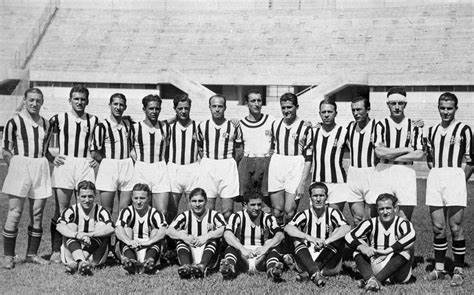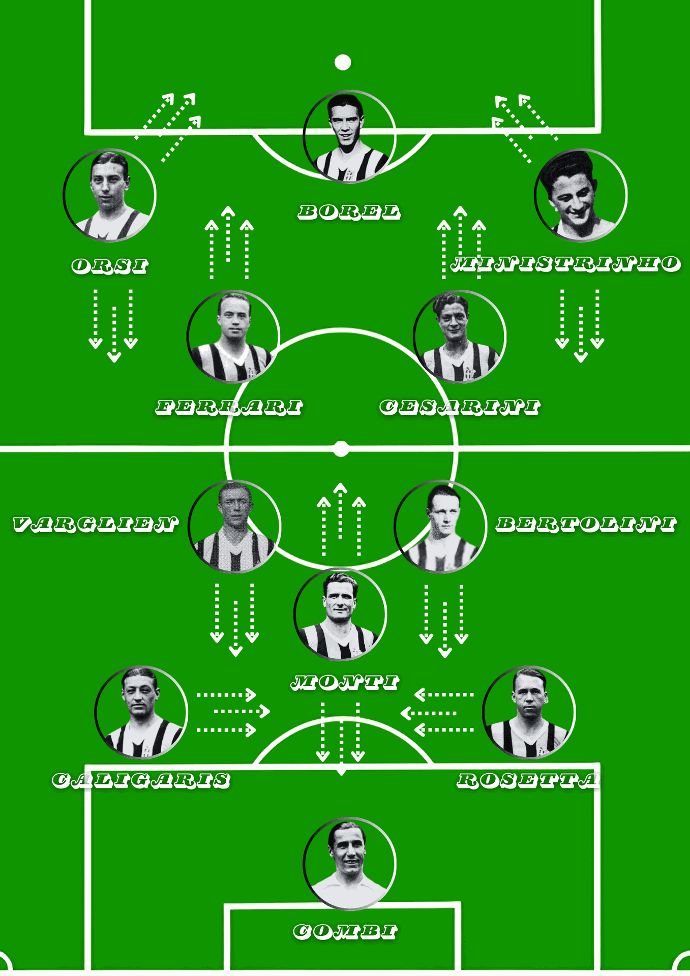The best Italian team of the early 1930s
One of the best teams in history
The golden five-year term refers to the Juventus team of the early 30s that would dominate Italy unchallenged.

The Metodo tactic
In a country, where there is only the championship to win (the Italian Cup being abolished from 1923 to 1935, there was even stronger competition for the title, which meant dominating the country without sharing. However, a team will crush the competition for 5 seasons, 5 seasons of madness, Juventus Turin.
After a time under the coaching of Billy Aitken, the legendary Scottish attacking midfielder, the club decided to leave the Italian Carlo Carcano in charge, who was notably a defensive midfielder for the national team. With him, the club is switching to a new tactic, a slightly modified WM in 2-3-2-3, also called the Metodo tactic. The tactic is intended to support the attackers thanks to the large number of midfielders in addition to the very fast wingers, and to strengthen the defensive trio Combi-Rosetta-Caligaris. This trio will be considered one of the best defensive trios of all time.
First success in a long series
With this new composition which highlights a certain Raimundo Orsi, one of the best wingers in history, the club will directly show what it is capable of. 1st match and 1st victory in the league, 4-1 against Pro Patria, hat-trick from top striker: Giovanni Vecchina. In the next match, Juventus defeated AC Milan 3-0 in Milan. The first 8 championship matches are victories. The Juventini machine seems launched, the club will string together prestigious victories: victory in Milan 3-2 against Ambrosiana-Inter, victory 5-1 against Pro Vercelli (one of the best Italian clubs of the early 20th century in Italy), victory in Naples 2-1 against Napoli, and victory 3-1 against Lazio Rome.
Juventus wins the championship with 55 points, 4 points ahead of AS Roma, and in style! The club scored 79 goals for only 37 goals conceded. 25 wins, 5 draws, 4 losses, total victory. The club therefore qualified for the Mitropa Cup but was directly eliminated by Sparta Prague during a support match (after 2 matches ended with a cumulative score of 2-2, penalties not existing , nor the away goals rule).
Raimundo scores 21 goals, Giovanni Ferrari scores 17, Giovanni Vecchina 16, Federico Munerati 14 and Renato Cesarini 9.
Departure of a legend, success and scandal
During the following season, 1931-32, Francesco Rier left the club, as did Carlo Bigatto, a true legend of the club (18 years at the club and 242 matches under the tunic of the bianconeri. The club which values bi-national foreign players ( Italians) will pick up the Brazilian-Italian Ministrinho from Palmeiras. Luigi Bertolini will consolidate the midfield.
The team saw the emergence of Luis Monti who was already one of the best Argentine players and had brought joy to San Lorenzo. With him, Juventus finds the defensive balance it was looking for. The player, small in size: 1m67, plays defensive midfielder, central defender or libero, he is ultra versatile and so solid that he convinces everyone with his talent.
Another player is more than excellent, midfielder Giovanni Ferrari, who is certainly one of the best Italian players in history, he will accumulate 44 caps with Italy between 1930 and 1938 for 14 goals. A versatile midfielder, he had a tendency to go very high and almost play as a second striker, as evidenced by his large number of goals.
During the 28th day, the title is almost at stake, Juventus and Bologna face each other, 3-2 victory against a great Bologna, Orsi who scores a penalty and Vecchina who scores a double are the heroes of this match. Juventus wins the Scudetto again with 54 points, 4 ahead of Bologna, in total the club once again has an exceptional season, 24 wins, 6 draws, 4 defeats. 89 goals scored for 38 conceded, whether attack, midfield or defense, all are excellent.
In the Mitropa Cup, Juventus first eliminated Ferencváros 7-3 on aggregate before facing SK Slavia Prague in the semi-final. But on June 10, 1932, during the return match, the match was stopped while Juventus led by two goals to zero. Slavia, after having conceded two goals quickly, multiplied obstructions and wasted time, which provoked the anger of Juventus supporters who went so far as to throw stones on the field, seriously injuring Planika one of the players of the Czechoslovak club. Slavia decided to leave the field and was confined for several hours in the locker room while 1,500 soldiers and police formed a security cordon. The Mitropa Cup committee, claiming that both clubs are responsible for these incidents, disqualifies them both.
The goalkeeper, Combi, who is surely the best Italian goalkeeper before World War II, had a superb season, 38 matches for 45 goals conceded and 14 clean sheets. Statistically it is Giovanni Ferrari and Raimundo Orsi who impress the most, the first scoring 19 goals in 38 matches and the second 24 goals in 38 matches.
The Borel phenomenon
The 1932-33 season was one of defensive accuracy, the defense was incredible. In the league, the club concedes only 23 goals, while scoring 83 times, the word to best describe this team is "balance". The club won the Scudetto again with 54 points, but this time the club was 8 points ahead of Ambrosiana-Inter who finished second.
One man scored this edition of Serie A, Felice Borel, the Italian striker who was only 19 at the start of the season scored a total of 29 goals in the league, finishing top scorer in Serie A ahead of big names like Angelo Schiavio, Giuseppe Meazza or Antonio Vojak.
The club therefore plays the Mitropa Cup again, during the 1st round, the club beat the Hungarian club Újpest FC 10-4 on aggregate, then was knocked out again in the semi-final 4-1 on aggregate against Austria Vienna . However, Raimundo Orsi scored 5 goals in the competition and established himself as the team's best offensive player.
The notable statistics in all competitions are those of Gianpiero Combi who has had another exceptional season with 38 matches played, only 31 goals conceded and 18 clean sheets in a period where clean sheets are rare. Orsi scores 15 goals in 36 matches. Giovanni Ferrari has 12 in 37 matches. Felice Borel scored 30 goals in 32 matches, Borel scored 5 doubles and 3 hat-tricks in the league.
Borel, the best young player in the history of Serie A, the national team or the Juventus Turin national team?
During the 1933-34 season, which was seen by the country's leaders as preparation for the 1934 World Cup, the Juventus club was in the spotlight and was not going to disappoint. Juventus won the Italian championship for the 4th consecutive time, ahead of Ambrosiana-Inter by 4 points and their 49 points. The Juventus attack strikes again, with an iron defense to cover the spaces.
In total, the club scored 88 goals and conceded only 31 in the league. Felice Borel finished top scorer in the championship with 31 goals scored, far ahead of second place Giovanni Busoni and his 24 goals. Once again the club loses in the semi-final of the Mitropa Cup, but the main thing is there, Juventus is the biggest club in the country. And so it is logical that its best players join the Italian national team, but no one could have imagined so many players. 9 Juventus players are among the 22 players selected for the World Cup, a World Cup which will be won by Italy, many historians say that Italy owes this success to Juventus.
The statistics of Juventus players that season are breathtaking: Felice Borel scored 37 goals in 40 matches, Borel scored 4 doubles and 2 hat-tricks in the league ; Giovanni Ferrari scores 18 goals in 40 matches; Raimundo Orsi, a little further behind, scored 10 goals in 30 matches; Renato Cesarini scores 10 goals in 24 matches; and Combi only concedes 37 goals in 35 matches for 11 clean sheets.
An aging team clinching one last title
Returning from the World Cup, the Italian players wanted to continue their momentum during this 1934-35 season despite an aging team: Gianpiero Combi 32 years old, Umberto Caligaris 33 years old, Virginio Rosetta 33 years old, Luis Monti 34 years old. , Bertolini 31 years old, Renato Cesarini 29 years old, Giovanni Ferrari 27 years old, Mario Varglien 29 years old, Raimundo Orsi 33 years old for example. Felice Borel is an exception at 21 years old.
But the team is still doing very well, and the club will make some small adjustments at the start of the season, so Mario Genta, Marcello Mihalich and Ministrinho leave the club. Alfredo Foni, Guglielmo Gabetto, Luciano Ramella and Pietro Serantoni join the club.
That season, the club first won the Coppa Pettinatura Lane, 2-0 against Pro Vercelli then the Trofeo Medaglia d'oro Caimi against Ambrosiana-Inter 4-3 in a crazy match. Borel opened the scoring in the 23rd minute, Meazza equalized in the 50th, before scoring a double in the 72nd, Mazzoni scored one more goal for Ambrosiana-Inter. With their backs to the wall, Juventus pushed and went more towards the attack, Raimundo Orsi scored the 3-2 goal in the 80th minute, before scoring a second goal in the 83rd, Felice Borel scored the winning goal in the 87th minute, a legendary match.
In the championship, the team seemed to be in a winning routine and won the championship for the 5th time in a row. This time with 44 points, only 2 points from Ambrosiana-Inter. The club only scored 45 goals in the league, but its iron defense only conceded 22 despite Caligaris coming on as a substitute for Alfredo Foni.
Borel only scored 18 goals in 36 matches in all competitions that season, but still scored 3 doubles in Serie A and 3 doubles in the Mitropa Cup. Giovanni Ferrari scores 13 goals in 33 matches, the team seems tired, firstly by age but also by the numerous physical efforts in previous years.
In the Mitropa Cup the club lost again in the semi-final, following a support match lost 5-1 against Sparta Prague, it was the end of this golden age of Juventus, which will be remembered for his Quinquennio d’oro.
Trophies :

Serie A x5
- 1931
- 1932
- 1933
- 1934
- 1935
Coppa Pettinatura Lane x1
- 1934
Trofeo Medaglia d'oro Caimi x1
- 1934
